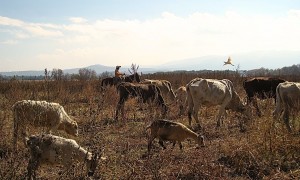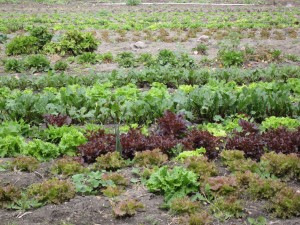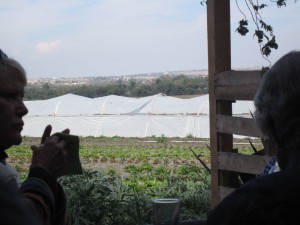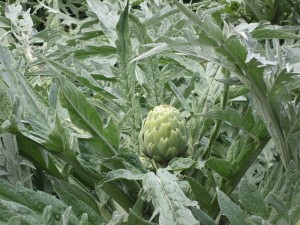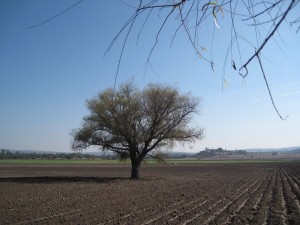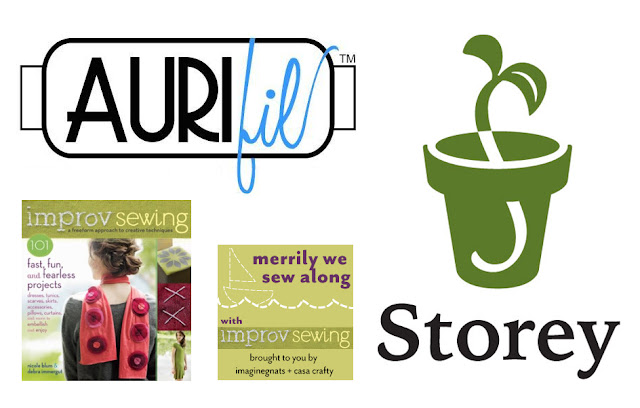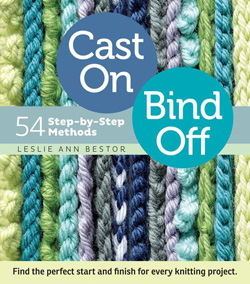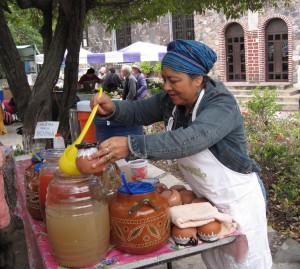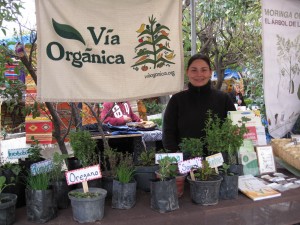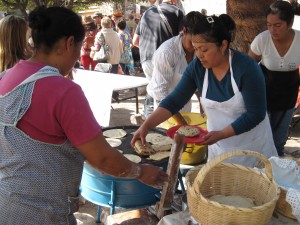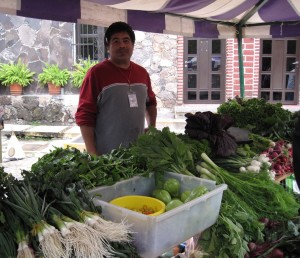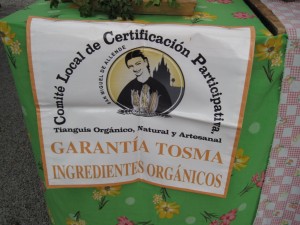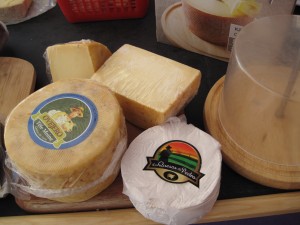Our son Michael has been working in North Dakota since the end of October, driving trucks, trying to make a little extra money to help make their bank payments this winter, so my husband Lynn and I have been helping our daughter-in-law Carolyn feed their cattle while he’s gone. Michael was home for a few days at Christmastime and showed them how to run his big bale processor that chops up the hay — making coarse hay more palatable and putting it in a windrow for the cows to eat.
Feeding cows with bale processor
On Friday, January 8, it was Lynn’s turn to feed with the processor, since Carolyn had to work at the local vet clinic. When he drove out to the field, he saw a newborn calf following its mama (an old cow, number 206) to the feed ground.
It’s been awhile since we’ve had new babies in January! Lynn and I calved our cows in January for more than 30 years, to have the cows all bred again in April before they went to summer range in May. That way they could be bred to our own bulls, with selected mating for each cow. We could use easy-calving bulls for the heifers and make sure we didn’t breed a cow to her own sire; we also didn’t have to worry about breeding-transmitted diseases such as vibrio or trichomoniasis that might be spread by neighbors’ bulls. On our rugged big-range pastures, breeding on the range is always challenging because cattle are widely spread and the bulls don’t always find them at the proper time, resulting in a longer, strung-out calving season. Our fertile crossbred cows always bred in about 30 days, here on our home pastures.
Calving in January, we rarely lost any calves at birth in our 180-cow herd. During cold weather we put the cows in the barn when they went into labor, and we were there for every birth — able to correct any problems. The young calves rarely got sick with scours because our fields and pastures were frozen and clean rather than muddy or sloppy with manure.
Calves playing in snow
Winter calves
Calving in late April or May when weather is warmer, with green grass, wasn’t an option back then, unless the cows calved out on the range, more at risk from predators. They had to go to summer range so we could put up hay on our fields at home.
Cattle on summer range
After we sold most of our cows to Michael and Carolyn, when they were running several leased ranches, we didn’t need to put up as much hay for our smaller herd, and we could keep our cows home during summer. At that point we changed to calving in April and May.
Michael and Carolyn quit leasing the extra ranches a few years ago, however, when rent costs went too high. They sold most of their cows to pay off some bank loans. Last summer they bought some pairs and pregnant cows to run on our upper place and essentially start over again.
Most of the cows Michael and Carolyn bought last summer had very young calves at side or were ready to calve, but three of those cows had large calves and might have been bred before they were sold. When our vet preg checked them a few weeks ago, he said one old cow, number 206, would probably calve in January but the other two wouldn’t calve until April. We weren’t too eager to have a January baby because these purchased cows had an unknown handling history. Some are aggressive mothers that attack anyone who comes close. We didn’t want to have to try to put one in the barn.
It was cold (12 degrees) and windy the night old 206 calved, but she probably calved in the brush where the cows have been bedding. The new calf was dry and had nursed and seemed okay. The next morning it was 15 below zero, and we were glad that old 206 had calved the night before, when it was warmer. Her baby, a feisty heifer calf, was managing fine, with the windbreak shelter of thick brush.
It was cold again on Sunday, and when Lynn and Carolyn fed the cows, they discovered another newborn calf — from one of the cows the vet thought would calve in April. The calf was cold but had nursed at least one teat. It seemed okay the next day, but when our daughter Andrea and Carolyn fed the cows on Tuesday, they thought the calf was dead. It was lying on the old feed trail, on its back and stuck between two big frozen manure piles.
The calf raised its head when they approached with the tractor and processor, however, so they jumped out, with an ax handle for a weapon in case the mother cow was aggressive, and grabbed the calf. It was a big calf, weighing about 90 pounds, and it was all Andrea could lift. She handed the calf to Carolyn and climbed up into the tractor, grabbing the front legs of the calf to pull on as Carolyn handed it up and pushed on the back end. They got it into the cab, and it rode around with them to finish feeding, which was a challenge with not much room in the tractor, then brought it to the house.
We spent the rest of the day trying to thaw out that calf. It must have been stuck on its back, unable to get up, for quite a while. Perhaps a cow knocked it down or rooted it out of the way while eating hay, rolling it onto its back between the frozen manure piles. Her feet were stiff and cold. Her body temperature was below 80 degrees because it didn’t register on my thermometer. We lay her on blankets by the woodstove with a hot pad under her, using warm water on her cold stiff feet.
Andrea and Carolyn thawing out the calf
I injected dextrose under her skin in several places, and after we started warming her, we gave her 1½ quarts of warm water with powdered colostrum mixed into it, by stomach tube. We use a nasogastric tube (into the nostril, to the back of the throat, down the esophagus and into the stomach). We thought the colostrum product might provide more energy than regular milk replacer. The calf apparently hadn’t nursed for a while; she was dehydrated and didn’t urinate until evening, when we gave her another quart and a half of colostrum mix by tube.
Carolyn and Lynn feeding the calf with a nasogastric tube
By that time her temperature was finally rising, up to 95 degrees at 4 p.m. and 99 degrees by 6 p.m. Normal for a calf is 101.5 degrees. She was finally strong enough to stand. Lynn and Carolyn took the calf up to Carolyn’s basement, to a makeshift corral of furniture near the woodstove. Carolyn fed it a bottle at 2 a.m. and again at 8 a.m., and the calf nursed eagerly. She stayed home from work the next day, and after she and Andrea fed the cows, they brought the calf back down and put it back out with its mother.
The cow was confused, perhaps because the calf smelled different with all our handling. She started kicking the calf when it tried to nurse, so Andrea and Carolyn herded the pair to the barnyard. The cow tried to run off a couple of times, but Carolyn kept bringing the calf and Andrea kept herding the cow. Once we got the pair into the corral, the cow let the calf nurse, and we could see that part of the problem was a very sore hind teat — the tip was raw from frostbite.
So we put the pair into a small pen by our barn where we can monitor them. We shoveled snow away and bedded it with hay. The old cow is pretty smart and acts as though she’s been handled on foot before; she’s not as wild as some of the other cows they bought last summer and made herself at home in the pen, grateful for the extra hay and water. She acts as if she’s been in a small pen before. Andrea and Carolyn carried her some alfalfa hay, and the next time they went back to check on her, she looked at them, then sniffed the ground, expecting them to feed her some more!
She’s an old cow, without much milk, but we can pamper her while she’s here by herself — and the calf will probably do okay. She’s letting the calf nurse three teats, and probably after awhile, the sore one will heal.
When we checked on the pair at dark, the baby was tucked in the hay between Mama and the plywood windbreak. The next morning the calf was cold (since the outdoor temperature was 12 below zero) but nursing, so it looks like this will work, and we won’t have to raise it on a bottle.
Heather Smith Thomas raises horses and cattle on her family ranch in Salmon, Idaho. She writes for numerous horse magazines and is the author of several books on horses and cattle farming, including Storey’s Guide to Raising Horses, Storey's Guide to Training Horses, Stable Smarts, The Horse Conformation Handbook, Your Calf, Getting Started with Beef and Dairy Cattle, Storey's Guide to Raising Beef Cattle, Essential Guide to Calving, and The Cattle Health Handbook.













